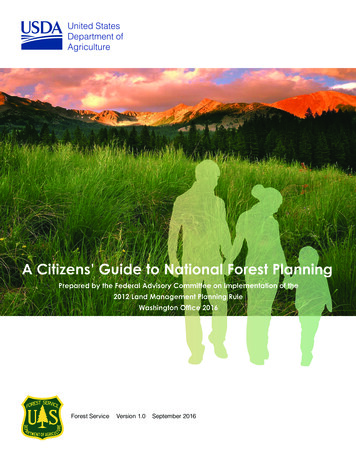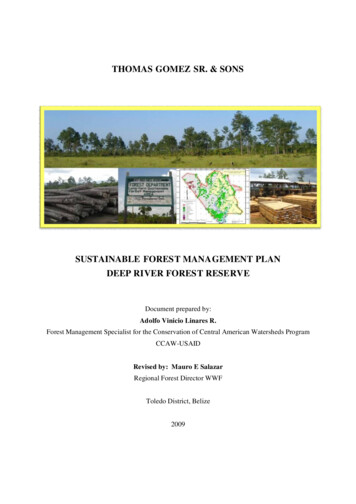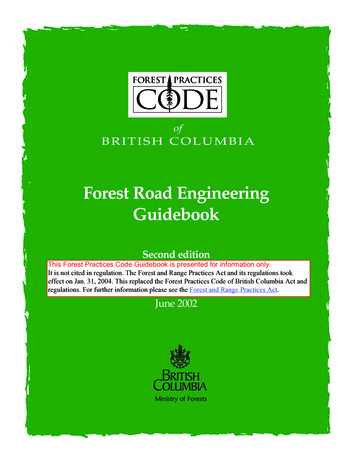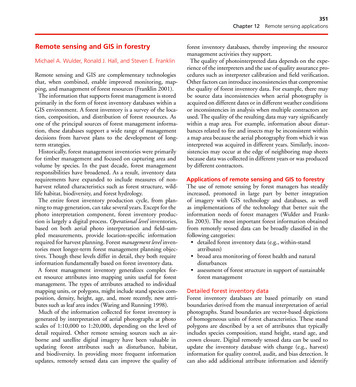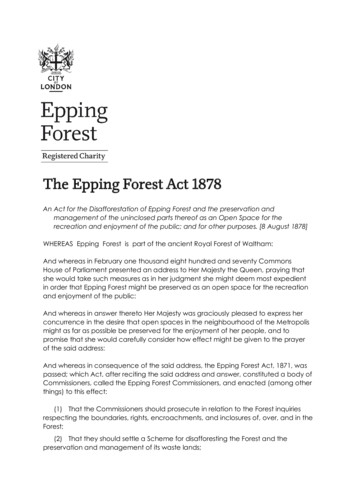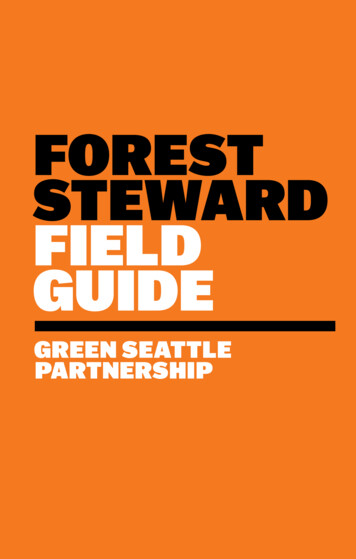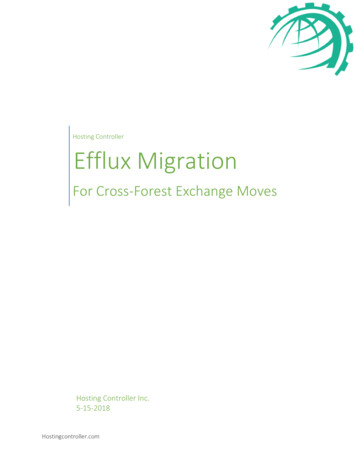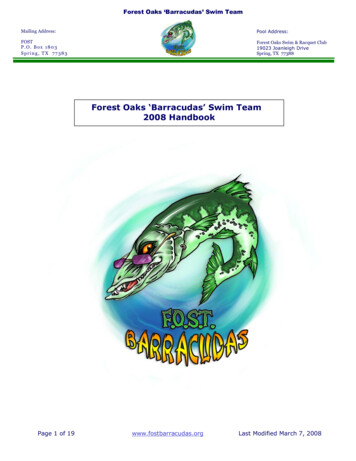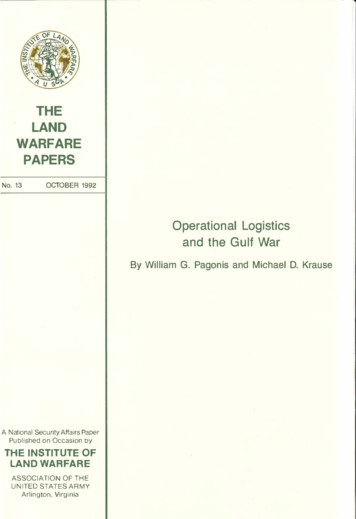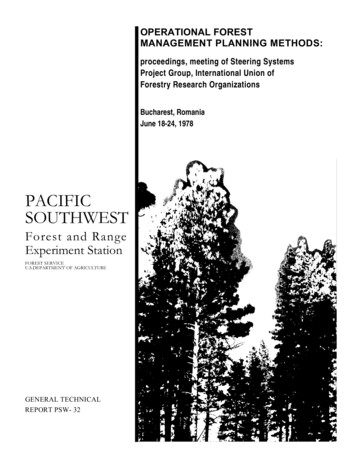
Transcription
OPERATIONAL FORESTMANAGEMENT PLANNING METHODS:proceedings, meeting of Steering SystemsProject Group, International Union ofForestry Research OrganizationsBucharest, RomaniaJune 18-24, 1978PACIFICSOUTHWESTForest and RangeExperiment StationFOREST SERVICEU.S.DEPARTMEN'I' OF AGRICULTUREGENERAL TECHNICALREPORT PSW- 32
OPERATIONAL FORESTMANAGEMENT PLANNING METHODS:proceedings, meeting of Steering Systems Project Group, InternationalUnion of Forestry Research OrganizationsBucharest, RomaniaJune 18-24, 1978Daniel Navon, CompilerCONTENTSPageA Method of Forest Management for the Planned Introductionof Intensive Husbandry in Virgin Forest Stands . 1B. DolezalTheoretical and Computational Foundations of ManagementClass Simulation . 7Denie GeroldA Computerized Tree Growth Projection System for Forest ResourceEvaluation in the Lake States . 13Allen L. Lundgren and Burton L. EssexTechniques of Australian Forest Planning . 24Australian Forestry CouncilOperations Research Techniques in the Managementof Large-Scale Reforestation Programs . 36Joseph Buongiorno and D.E. TeeguardenWood Transportation Systems-A Spin-Off of a ComputerizedInformation and Mapping Technique . 45William W. Phillips and Thomas J. CorcoranOptimal Control of Raw Timber Production Processes . 54Ivan KolenkaLarge-Scale Budget Applications of Mathematical Programmingin the Forest Service . 60Malcolm KirbyForest Management Planning for Timber Production: A Sequential Approach . 68Krishna P. RustagiA Two-Phase Method for Timber Supply Analysis . 76Stephen SmithTimber Management Planning with Timber RAM and Goal Programming . 82Richard C. FieldAnalytical Aids in Land Management Planning . 91David R. BettersNutzwertanalyse . 100A. HenneA Methodology for Decisionmaking in Project Evaluationin Land Management Planning . 109A. WeintraubPacific Southwest Forest and Range Experiment StationP.O. Box 245Berkeley, California 947011978
Navon, Daniel, Compiler1978. Operational forest management planning methods: proceedings,meeting of steering systems project group, International Union of Forestry Research Organizations, Bucharest, Romania, June 18-24, 1978.Gen. Tech. Rep. PSW-32, 117p., illus, Pacific Southwest Forest and RangeExp. Stn., Forest Serv., U.S. Dep. Agric., Berkeley, Calif.These 14 papers were submitted to a conference of Project Group P4.07 DivisionIV, International Union of Forestry Research Organizations. Topics discussedincluded the uses of simulations, analytical techniques, and mathematical programming techniques in land management planning, reforestation programs, intensive forestry, timber management and production, tree growth, wood transportation, and budgeting.Oxford: 6[--015.5 3]Retrieval Terms: operations research; analytical methods; simulation; land-useplanning; reforestation; intensive management; timber management; resourceanalysis.CompilerDANIEL NAVON is an economist in the Station's land management and landscapeplanning methodology research unit, with headquarters in Berkeley, California.The AuthorsAUSTRALIAN FORESTRY COUNCIL, Banks Street, Yarralumla, A.C.T. 2600, Australia; DAVID R. BETTERS, Department of Forest and Wood Sciences, Colorado StateUniversity, Fort Collins, Colorado 80521, USA; JOSEPH BUONGIORNO, ForestryDepartment, University of Wisconsin, Madison, Wisconsin 53705, USA; THOMAS J.CORCORAN, University of Maine, Orono, Maine 04473, USA; B. DOLEZAL, Schoolof Forestry, Brno Agricultural University, Brno, Czechoslovakia; BURTON L. ESSEX,North Central Forest Experiment Station, 1992 Folwell Ave., St. Paul, Minnesota 55108,USA; RICHARD C. FIELD, Southeastern Forest Experiment Station, Carlton Street,Athens, Georgia 30602, USA: DENIE GEROLD, Technische Universitat Dresden, Sektion, Forstwirschaft Tharandt, DDR 8223 Tharandt, Pinnerstr. 8; A. HENNE, Hess.Forsteinrichtungsanstaft, Gressen, Deutschland; MALCOLM KIRBY, Management Sciences Staff, Forest Service, P.O. Box 245, Berkeley, California 94701, USA; IVANKOLENKA, University College of Forestry and Wood Technology, Zvolen, Czechoslovakia; ALLEN L. LUNDGREN, North Central Forest Experiment Station, 1992 FolwellAve., St. Paul, Minnesota 55108, USA; WILLIAM W. PHILLIPS, University of Maine,Orono, Maine 04473, USA; KRISHNA P. RUSTAGI, College of Forest Resources,University of Washington, Seattle, Washington 98105, USA; STEPHEN SMITH, BritishColumbia Forest Service, Victoria, British Columbia; DENNIS E. TEEGUARDEN,College of Natural Resources, University of California, Berkeley, California 94720, USA;A. WEINTRAUB, University of California, Berkeley, California 94720, USA, andDepartamento de Industrias, University of Chile, Cassilia 2777, Santiago, Chile.
PREFACEAt the XVIth World Congress held in Oslo, Norway, in 1976, the International Union of Forestry Research Organizations (IUFRO) reaffirmed its commitment to study forestry problems in the developingcountries and to seek solutions. This collection ofpapers is the contribution to this task made by theSteering Systems Project Group, Division IV. Thisproject was established at the Congress at the suggestion of Hans Speidel, Richard Plochman, and RobertMagin, to promote communication and collaborationamong IUFRO scientists doing research in the development and application of forest management planningmethods. The Project Group is conducting two majoractivities. First, an International Directory of Computerized Planning and Research Tools is being established under the sponsorship of the Forest Service,U.S. Department of Agriculture. Second, internationalmeetings are held to inform members of the state of theart in forest management planning, and to promote thecollaboration of all forestry researchers in addressingthe challenges posed by forest management in developing nations.The 14 papers collected here report on planningmethods which have been successfully used in developed countries and which―in the judgment of themembers of the Project Group―may be useful in attacking problems in less developed nations. Many ofour members are deeply aware of their limited grasp ofthese problems. Our sincere hope is the these paperswill open a dialogue which will lead to better understanding of these problems and to an effective collaboration among researchers from all nations in an attackon these problems.The papers presented here span the spectrum ofapproaches used in forest management planning inrecent decades. In the first paper, Bohumil Dolezalpresents the classical approach to planning intensiveforest management and establishes the validity of theseprinciples for dealing with contemporary problems ofdeveloping economies.The remaining papers deal with specific planningtechniques, all of which―except two―require the useof electronic computers to conduct simulations, solvemathematical programs, or invert input-output matrices. The papers by Denie Gerold and AllenLundgren demonstrate the usefulness, efficiency,modest cost, and versatility of electronic computers inmodeling the behavior of forest stands, and in providing detailed estimates of outputs and of resourcesneeded for the diverse conditions typicallyencountered in commercial forest lands.The paper contributed by members of the AustralianForestry Council reports on six stand-growth andyield-simulation models which rely on functions derived from graphic analysis, nonlinear estimation, andgeneralized least squares. This paper also reports ontwo linear programming (LP) methods. The first ofthese provides an analysis of long-term cutting strategyfor intensively managed Pinus radiata plantations.The second combines LP with the simulation of standyields determination of thinnings and clear fellingyield for an entire plantation.Two additional papers report on methods integratingsimulation and optimization methods. The model described by Joseph Buongiorno and Dennis Teeguardenuses simulation to estimate future growth, and to helpmanagers select promising management alternatives,and linear programming to find an optimum combination of reforestation projects. William W. Phillips andThomas D. Corcoran present an interactive modelwhich uses simulation to explore alternative "markettransport possibilities," and linear programming foridentifying optimal overall strategies.The next five papers report on methods which relyon the use of LP and a recent extension of LP, goalprogramming. Ivan Kolenka presents a model forplanning the logging, transport, and distribution ofwood assortments in the context of a planned economy. Malcolm Kirby presents a budgeting model forlarge private or public forest enterprises which alsoprovides an analytical framework for evaluation ofoverall management programs. The two-stage LPmethods discussed in separate papers by Krishna Rustagi and Stephen Smith provide a practical strategy fordealing with one of the most vexing limitations of LP,the assumption of the availability of reliable information about future events. Richard C. Fields describes agoal programming model which provides a systematicmethod for dealing with a limitation of LP which hasproved particularly bothersome in forestry, the impossibility of specifying an objective function which reflects adequately the incommensurable outputs of forest management.David Betters reports on a model which integrates acomputerized procedure based on factor analysis withlinear programming and input-output analysis. Thecomputerized procedure is used to develop amongplanners, consumers, and managers a consensus of
resource use preferences. Linear programming thenprovides optimal combinations of forest managementalternatives and an input-output model estimates theimpact on local economic activity and employmentlevels.The last two papers discuss systematic proceduresfor evaluating well-defined forest management alternatives, without paying tribute to computers. AugustHenne presents an operational version of Zangemeister's Nutzwertanalyse, which retains the essential features of the original scheme for ranking a set of complementary projects. Andres Weintraub reports on aheuristic procedure for selecting a management program from among mutually exclusive alternatives.The preparation and publication of this collection ofpapers was made possible through the collaboration oftoo many persons to permit giving them individuallythe acknowledgement and thanks which are due them.Goran von Malmborg, co-chairman of the SteeringSystems Project Group, and all our members join me inexpressing special thanks to Professor Robert Maginfor inviting us to meet with the Forest ManagementPlanning and Managerial Economics Working Groupand to Professor Adolf Priesol and Director GeorgeBumbu for their warm hospitality. We also extend ourspecial thanks to the Food and Agriculture Organization of the United Nations for allowing Dr. ArnoldoContreras to share with us his clear understanding offorestry problems in developing countries, and for helpFAO is giving us in reaching our colleagues in thosecountries.The publication of this collection of papers wasfunded by the Research and National Forest Systembranches of the Forest Service, U.S. Department ofAgriculture.Trade names and commercial enterprises or products are mentioned in this publication solely for information. No endorsement by the sponsoring organizations is implied.
A Method of Forest Managementfor the Planned Introduction ofIntensive Husbandry in VirginForest StandsB. DolezalAbstract: The method proposed is derived from longexperience of intensive management in forest stands ofCentral Europe and from our proposal for management invirgin Iranian forests of the Caspian Region. The methodestablishes the need for systematic planning of standconversion to insure both sustained yield and the harvesting of sufficient timber to sustain economic development. The method also recognises the need to integratethe planning of silvicultural activities with capitalinvestments in roads and machinery.INTRODUCTIONThe method described in this paper is based on the realization that forestplanning must be consistent with the political and economic situation of a developing country, as well as with the given natural and economic conditions,financial position, market conditions, and the technological procedures involved in the process of production, which are all traditionally taken intoconsideration in forest husbandry. A method of this kind is expected also toreflect the latest scientific achievements in understanding of the forest asan entity. Market conditions must be considered to insure a reasonable financial return from management. It must also be recognized that the forest isa national resource of special value in a country's watershed management andin the development of an environment beneficial to its population.The principles discussed below and incorporated in the method for introducing an intensive system of management into virgin forest stands were obtained partly from what has been gathered during the past 250 years of intensivemanagement in the forest stands of Central Europe, and partly from the experience gained while compiling our proposal for forest management in virgin Iranian forests of the Caspian Region. The method is based on the principles that(1) the introduction of an intensive system of management into the virgin-likeforest must be planned, and (2) once converted, the commercial forest must beable to produce sustained yields adequate in quality, volume, and monetaryvalue, and must supply the market with sufficient amounts of timber in thespecies and assortments needed for economic development.1
The method for introducing an intensive system of management as suggestedhere is based on the idea of short-term credits, which are required to makethe virgin stands accessible for management, for purchasing needed machinery,and if necessary, even for constructing wood-processing plants. The shortterm credit needed to secure accessibility of virgin-like forests can be estimated by assuming that the stand regeneration will progress through areasthat are spatially linked, so that the transport of wood from the part of theforest which has just been made accessible passes through those which have already been made accessible. The availability of short-term credit indeed appears to be an important requirement for the introduction of intensive management in the forests of developing countries.The suggested method is based on scientific knowledge of the forest. Itutilizes data on the geographical and ecological classification of forests,which serves to stratify forest land. This stratification is needed to delimit forest land planning and control units for management, to define the quantities to be estimated, and to elaborate the instructions needed to manage theforest.METHODEconomic Evaluation of Wood ProductionDelimitation of the Forest Land ResourceIt would not be reasonable to introduce intensive management into forestswhich, within a known period of time, are intended to serve some other type ofland utilization (such as fields, meadows, grassland, dwelling estates). Itis therefore urgent to determine, on the basis of consultation with competentinstitutions in the country, which of the forest areas will be left as permanent stands, regardless of population increases. This task appears to be urgent, especially in the territories which are characterized either by a highor by a very low forest cover percentage, compared to the targets planned forthe years to come.Survey and Analysis of Natural and Working Conditions in the ForestsThe primary concerns should be the survey and analysis of soil, climate,and terrain all of which are decisive for the future productivity of theforest stands. Survey and analysis should also be concerned with the presentcondition of the forest stands (existing species, diameter, health condition,forest inventory data, potential production of assortments suitable for commercial and industrial uses, and the like). The remaining items to be evaluated are: conditions for management, especially the character of the topography; potential accessibility of the stands and timber transport; delimitation of gravitational areas etc.; conditions for location of timber yardsand sawmills; the level of protection needed against forest fire and destructtive wind.Maps produced using photogrammetry are part of the surveys mentioned above.2
MarketingAn investigation is carried out to determine the opportunities for tradingtimber; to assess the demand for timber assortments by local population and industries, and to estimate the export requirements as well; finally, the potential for the processing of the timber harvest by woodworking plants isassessed.Organization of the Forest StandsWorking CircleThese are the "frames" for harvest regulation. 1he areas range from 15 to50,000 ha. They are designed to insure sustained, even, and sufficient supplies of timber, in order to simplify management, and to obtain the short-termfinancial credits needed to make the forest accessible to transport. Workingcircles cover contiguous areas encompassing entire watershed or timbershedswhich are homogeneous with respect to both natural and economic conditions.These working circles permit the application of a uniform method of managementand a uniform type of harvesting regulation. Relatively large areas arecovered by working circles. This is made possible by the introduction of theconcept of "working complexes" of stands, which refer to land units homogeneous with respect to production and management. The only role left for theworking circle is to insure sustained and even yields from the forest. Ifrequired, working circles can be drawn for forests managed for purposes otherthan timber production, e.g., protection forests, recreation forests, naturereserves, and the like.Working Complexes of StandsThese are defined as the groupings of forest stands with ecological, productional, and management characteristics so similar that they permit the introduction of a uniform system for (1) compilation of instructions for management, (2) calculation of the index of harvest regulation, and (3) calculationof the timing of management activities for the forest, etc. The reasons forintroducing the working complexes of stands into forest management are to makethe goals and the decisions of management concrete, to facilitate real planning and control of managerial actions, and to simplify the managerial process. Clearly the use of working complexes is indicated when a system of intensive management is introduced into virgin-like forests.Forest CompartmentsThese are defined as the permanent lard management units based on theforest's biological and management typification. They range in area from 30to 100 ha. Where possible, the forest compartments are marked off by distinctcharacteristics of the terrain. Their uniform morphological character shouldmesh with the network used for timber skidding, and with the road system.Moreover, the forest compartments are supposed to be independent units also3
from the point of view of forest protection. For this reason, preventivemeasures of protection are worked out for each compartment. Compartments aresurveyed and, as a rule, their boundaries are located using photogrammetry.The forest compartments are the basic units of the forest's spatial organization, both with respect to planning and with respect to the realization ofthe plan.SubcompartmentsUnder diversified natural and working conditions there are occasionalcases when the compartment cannot cover all ecological and stand differences;it then follows that the compartment is not a convenient unit for the planning, control, and realization of pertinent measures of management in the sectors of silviculture and forest protection. Instead, subcompartments are delimited as a lower category of the forest's spatial organization. The subcompartments are assumed to possess the same properties indicates above forthe compartments--those necessary for the uniform planning of management activities related to silviculture and forest protection. In this particularcase, the planning of timber transport and skidding occurs within the frame ofthe compartment.HARVEST REGULATIONThe principle observed is that optimum productivity be reached in the forest stands within the compartment or subcompartment; at the same time, theyields produced within the frame of the working circle must be sustained andeven. In compliance with the requirement for simplicity and the conditions indeveloping countries, harvest regulation should be based on area. It is truethat allowable cuts are derived on the basis of area and volume, as well as onassortments and value, but always so that considerations for the elements ofvolume are subordinated to those of area.Calculation of the Allowable CutThe final allowable cut is determined primarily by the "normal" fellingarea, according to the formula:e inhuwhere e denotes the volume of the allowable cut, in stands for the normalfelling area, in hectares, and hu designates the average volume per hectare ofthe growing stock within the working circle at the time of stand maturity.This average stock per hectare of the working circle is obtained with theformula:hu ΣihiFi/ΣiFiwhere hi denotes the per-hectare stock in stands of individual working complexes, Fi indicates the area in hectares of the ith working complex belonging to the working circle, and4
i F/uwhere F is the area of the working circle and u is the rotation of the working circle, calculated according to the formula:u EiuiFi/ziFiFor the volume index of harvest regulation it is possible to use the finalmean annual increment in stands of the working circle. This is calculated bysumming up the final mean annual increments achieved in all the individualworking complexes which constitute the working circle.The stand volumes per hectare of individual working complexes are obtainedby determining the growing stock volume per hectare in sample plots distributed in individual working complexes. Principles of systematic random selection must be observed to obtain representative estimates of the characteristics of the stands of the working circleConcerning the realization of the allowable cut: the main object of themethod proposed here is to promote the harvesting of the allowable cut in acontiguous area (French terms: quartier de regeneration, affectation unique).The method thus permits respecting the silvicultural requirements of stands inindividual subcompartments or compartments within the frame of the ecologicaland production conditions characterizing individual working complexes. Indoing so, harmony is achieved between the interests of silviculture and thoseof cutting regulation.For long rotations and the use of small-area harvesting sytems, the allowable cut in the quartier de regeneration is calculated from the formula:HO Ci P/2e Pwhere HO denotes the total volume of stands in the quartier de regeneration, P stands for the regeneration period (cutting cycle) expressed inyears, and Ci designates the current increment. The number of regenerationtreatments is determined with respect to the ecological requirements of thespecies represented in or introduced into the stands. Regeneration in thesubsequent quartier de regenerationn does not commence until completion ofthe stand regeneration in the quartier de regeneration immediatelypreceding.The harvesting in stands, except for the quartiers de regeneration justunder regeneration, is dependent on the possibility of transporting thematerial exploited. As a rule, the plan is to utilize the wood for charcoalburning, and only then carry it out of inaccessible stands on the backs ofmules or donkeys. Sanitary fellings are largely concerned with the removal ofsick, ill-shaped, overaged, and similar trees which if kept would not contribute to the value of the stand. The cycle for these treatments is usuallyfixed at 10 or 20 years; the volume of timber harvested per hectare in individual working complexes is estimated on the basis of a current survey of thecondition of the stands.5
SYSTEMS OF MANAGEMENT AND EXPLOITATIONThe method for introducing intensive management into virgin-like forestsassumes the use of a system of management and exploitation that is consistentwith the natural and economic conditions of the country concerned. The main--and highly desirable--objective is to avoid the destruction of the forest'ssources of production--the soil above all--due to erosion, waterlogging, orexcessive growth of woody plants. The selection of the system of managementis dependent also on the ecological requirements of the species in the specific stand environment, and on the technique of skidding to be employed. Ingeneral, it seems advantageous to prefer the small-area systems of management,the better to maintain the forest's production capability. This, however,should not exclude the use of regeneration cuttings when conditions aresuitable.CONCLUSIONSIn addition to what has been indicated above, the method of introducingintensive management into virgin forests assumes thorough planning to carryout the management practices effectively and to use expensive harvesting andtransporting machinery efficiently. Another requirement is that all the complex aspects of forest management be taken into consideration. The same amount of attention given to the harvesting of timber must be paid to afforestation of harvested areas and to the tending and protection of new stands. Theconstruction of a network of timber transport roads, adequately dense and dulydistributed in space (about 15 km/ha), is also a prerequisite.The method discussed in this paper is not only consistent with all thelatest achievements in Central European forestry, it is also consistent withthe natural, working, and politico-economic conditions found in developingcountries.6
Theoretical and ComputationalFoundations of ManagementClass SimulationDenie GeroldAbstract: Investigations on complicated, complex,and not well-ordered systems are possible only with theaid of mathematical methods and electronic data processing.Simulation as a method of operations research is particularly suitable for this purpose. Theoretical and computational foundations of management class simulation must beintegrated into the planning systems of forest managementand must provide a large number of alternatives for action.A model already in wide use is described.INTRODUCTIONResearch on complicated, complex, and not well-ordered systems is possibleonly with the aid of mathematical methods and electronic data processing equipment. With analytical model analysis (e.g. optimization models), the solutionalgorithm yields a specifically defined result, but computational experimentsare more or less systematic test procedures for which there is no logicallycertain procedure for optimal solution. The purpose of the computational experiment is to search for the optimal solution or the best corresponding decision. Complete and partial searches are differentiated according to thescope of search processes within the framework of a given decision model. Incomplete searches all possible constellations of variables are calculated, andthe optimum with respect to the objective concepts exists with certainty amongthe variants. The partial search is limited to a sample of all possiblesearches. It must be guaranteed that partial search procedures are directedtoward the research goal. Partial searches differentiate between pure simulation and "design game plan." In simulation one specifically formulatesdefinitions for actual decisions through decision rules at the beginning of aseries of searches. In the design game plan, the strategies for a searchseries are not fixed at the beginning of the game, but develop in the courseof the game as the result of chains of decisions.Simulation is suitable as a method for operations research because of itsadaptability for analysis of systems with numerous input and output quantitiesand complicated structures. It is distinguished by the following essentialcrite7
1. A system can be simulated if it can be subdivided into a variety ofelements for which the behavioral rules can be assigned.2. The simulation encompasses a mathematical model which "runs" but isnot solved; i.e., time is very important in the simulation.3. The process of system optimization is not directly contained in thesimulation.4. The output of the modeled system is weighted in the simulation withrespect to deterministic or stochastic modifications of the input.A number of steps must be considered in the development of a simulationmodel:(a) Formulation of goals(b) Formulation, weighting and comparison of possible alternatives(c) Selection of the best alternative with respect to the objectivefunction (decision)(d) Control of the elaboration of decisions and eventual correctivemeasures.The principle of the mathematical simulation is presented in figure 1.Figure 1--Principle of mathematical simulation in the form of a
ducing an intensive system of management into virgin forest stands were obtain-ed partly from what has been gathered during the past 250 years of intensive management in the forest stands of Central Europe, and partly from the experi-ence gained while compiling our proposal for forest management in virgin Iran-ian forests of the Caspian Region.
